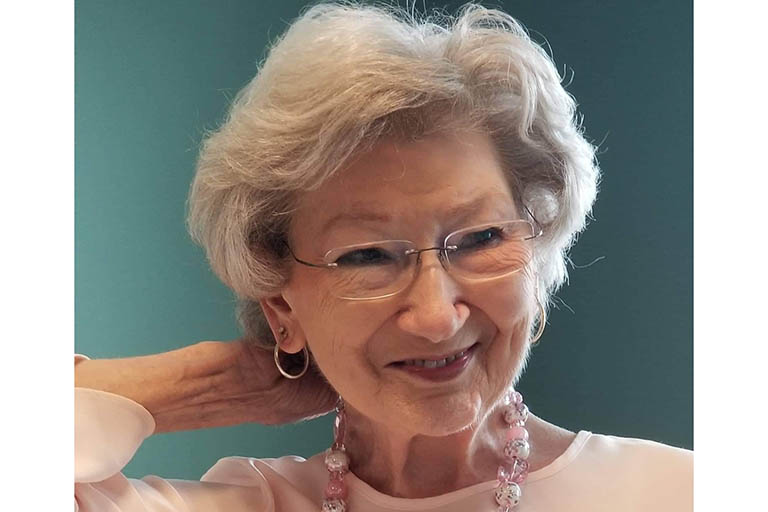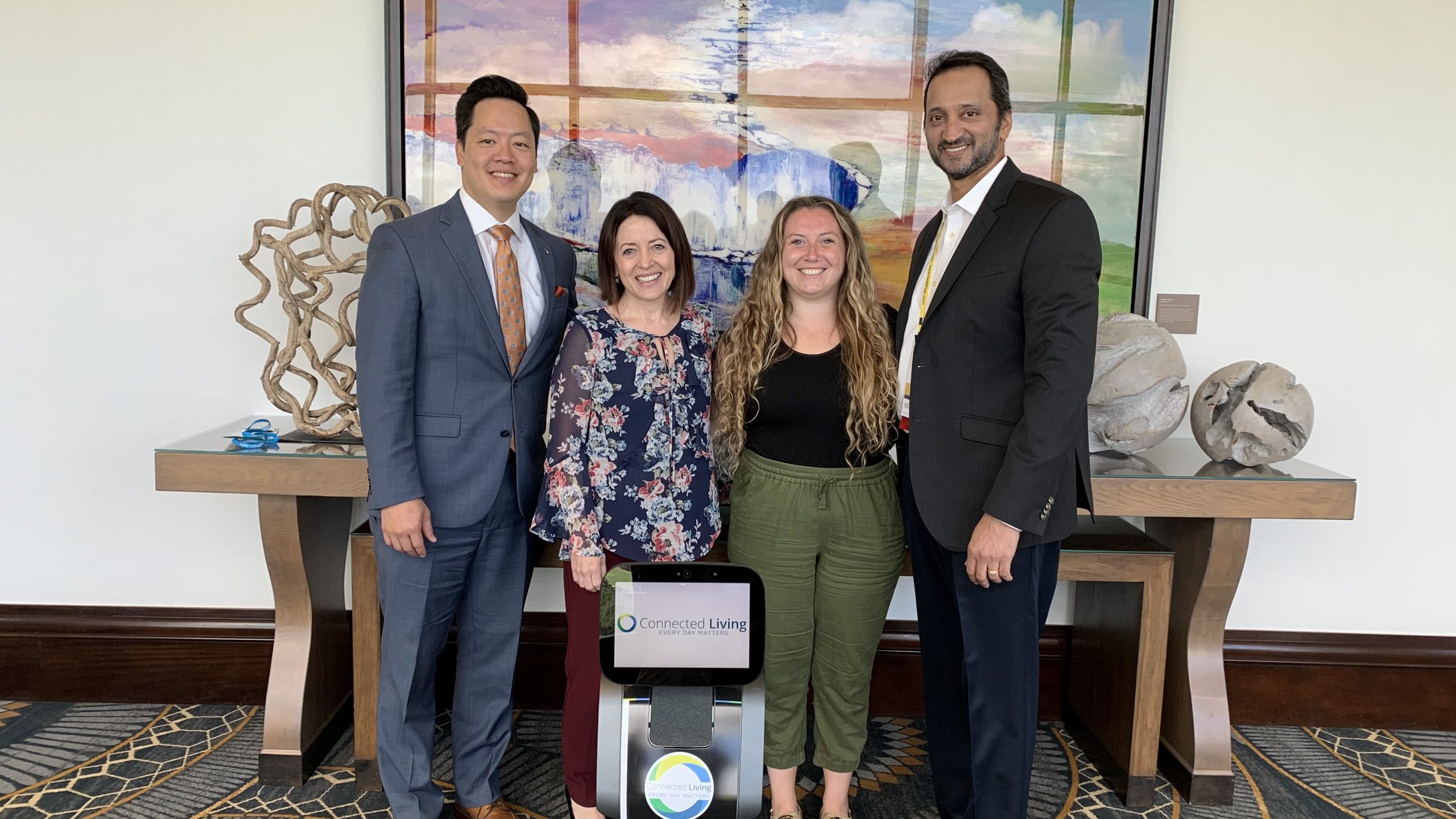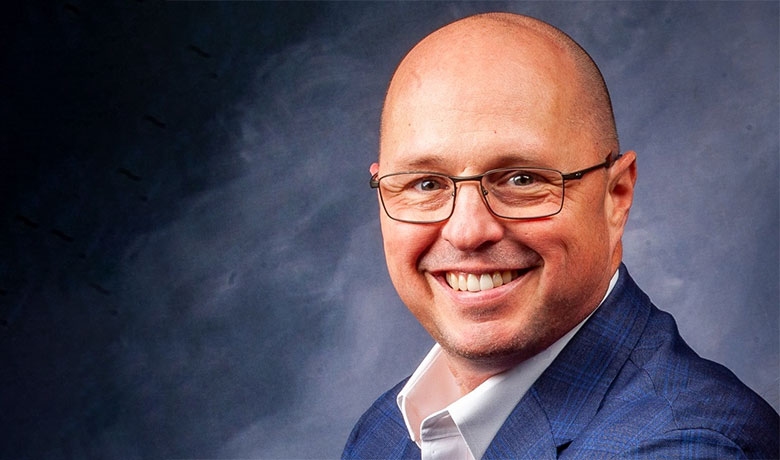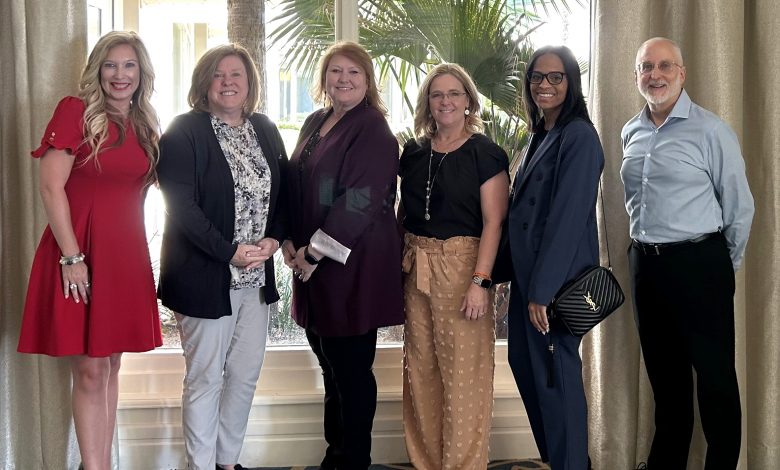
HEALTHTAC East 2024 Panel: Staffing Solutions — Retention
By Jim Nelson | March 27, 2024
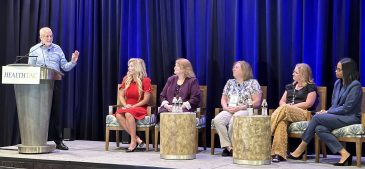
AMELIA ISLAND, FL — HEALTHTAC East 2024, a senior living-centered retreat at The Ritz-Carlton on this small island near Jacksonville, Florida, is now behind us so we’re spotlighting some of the key takeaways from its four panels. I moderated each panel (HEALTHTAC is the sister company of Senior Living News).
In the first panel we explored the recruiting side of staffing. On our next panel, we looked at the opposite side of that coin: once you get good staff members, how do you keep them?
All five panelists said their company’s retention has improved the past 12 months, and they described how they turned it around.
“Through concentrated effort between operations and human resources,” said Amy Birkel, the COO at Heritage Communities, “It can’t just be on the H.R. side; it can’t just be on the Ops side — you’ve got to partner together to make it happen.”
“We too, have dedicated all of our resources towards making sure that we not only recruit, but we retain our good staff,” added Amy Eubank, Silver Birch Living’s vice president for operations. “We have dedicated a lot of time resource as well as monetary resource.”
“We are really approaching recruitment and retention like we do with marketing,” Greystone Communities’ Vice President of Operations Julie Fenske mentioned. “We brought in a full-time recruiter.”
“The pandemic allowed us to really focus on our team and because of that we’re starting to see the benefits,” said Shelly Griffith, Eben Ezer Lutheran Care Center’s CEO.
“We are very intentional about watching our data,” Candace Johnson, the VP of human resources at Arrow Senior Living, shared. “We’re not afraid to take a dip in retention, because a lot of times that step back is a step you need to be retaining the best quality employees. So not only is retention going in the right direction, but I feel confident that the people that we are keeping are the people that we really want.”
Thinking about why people choose to leave, Amy Birkel commented on the importance of digging deeper than the symptoms to address the root causes of staff exits.
“I think it’s important [to] survey, if you do a 30-, 60-, 90-day for your new hires,” she said. “Sixty-five percent of our folks, if they’re leaving, leave in the first 100 days. So, you get the survey information, which is great, but then you’ve got to have a person present — not just an email; you’ve got to ask clarifying questions, make sure you actually understood what the root issue is to the dissatisfaction. And then you have to execute on that.”
“I agree with Amy in all of that,” Johnson said. “The only thing I would add is being intentional about who you are getting feedback from. I’ve learned that sometimes employees just aren’t comfortable being honest; we don’t get the best answer. Sometimes in the survey it takes getting face to face with those employees in that first 90 days, and sometimes it takes having a peer rather than someone on your leadership team.”
“I love that,” Birkel responded. “One thing we do is skip-level interviews — you skip over the direct supervisor, so my direct reports are talking to the owners. Same thing with my team — the folks that directly report to the people that report to me, I’m checking with them. If you’re not quite comfortable talking to your direct supervisor about something you’re unhappy with that’s how we try to combat that.”
The panel conversation then turned to company culture and fostering a sense of belonging with the staff.
“We start day one,” said Fenske. “The minute that they interview with us we are asking questions about how they’re going to fit into our culture, behavioral-based questions. We actually spent a lot of time studying the Ritz-Carlton concept and the principles of excellence, and we have put those into place at all of our communities.”
Eubank discussed ways that Silver Birch expresses recognition to its staff.
“We have dedicated a lot of resources towards appreciation of our staff,” Eubank told the audience. “In the recent year, we looked at how much we were spending as it related to recruitment and retention issues and that came up to be about $100,000 per community when you average out $5,000 to $6,000 worth of turnover per employee. With that being said, we dedicated that to a positive approach and developed a program called Investing in Excellence. That program had three key components: One was a Learn and Earn program — a catalog similar to what you give to somebody who’s getting ready to go to college. This was an opportunity for our culinary directors to learn about environmental services; our CNAs to possibly get their ServSafe manager specification. Not only did we pay for the course, we paid for the time that they were in the course, and we also gave them a monetary supplement. They enjoyed that because not only did it put more money in their pocket, it gave them growth opportunities as well.
“In addition to Learn and Earn,” Eubank continued, “we also have a Care and Share program for anybody who’s going through troubled times. They know that they can rely on a fund if they maybe have a fire or if they have a spouse or a significant other that has become unemployed.
“The third component,” she concluded, “is we reward our employees by being able to have a healthy meal for their entire family every single month, and it’s on us. We do it through our food distributor.”
Griffith then shared one way in which Eben Ezer Lutheran Care Center focuses on its company culture while showing appreciation for its staff.
“Recently our culture committee implemented Food Truck Friday — who doesn’t love food trucks, right?” she said. “Food Truck Friday has become a hit; the intent was for our elders and our team members on the campus, but it really has become a big communitywide effort. People are looking at our Facebook page and they’re calling to find out what food truck is going to be there Friday. It’s been fun.”
“One of our biggest things is our tuition reimbursement,” Arrow’s Johnson added to the topic. “You don’t have to go to a specific school or be a part of a specific program, it’s really just our investment to our employees. Additionally, we offer leadership development, which is one of those things where you think, ‘Someone might take this and go somewhere else,’ but as long as you are your best self with us, that is good enough for us. Arrow’s philosophy is we want to be better for the industry, so if we are developing great leaders that ultimately find a place somewhere else, we’re okay with that, too. But rather than the small burst of energy, we really do try to holistically develop our employees so that they stick around.”
And what about ways to show appreciation with zero budget?
“Be genuine,” said Birkel. “I think it’s being visible in your communities, role modeling the kind of culture that you want, being willing as a leader to recognize teaching moments when you see something that maybe one of your leaders or someone else fell a little short of, to pull them aside because you care enough to course correct a little bit or help them see it through your eyes. Culture can’t be person dependent. If I’m gone at a conference in Florida, I’ve got to know that things are good at home, and that culture is systemic now. I think it’s just being yourself, being present, being engaged, knowing your folks; that costs nothing.”
“Thank people for their work and be genuine,” Greystone’s Fenske noted. “It doesn’t cost anything to make sure that you’re recognizing birthdays and anniversaries. We also tap into our vendors and to our partners numerous times during the year — we try to be mindful of it — to ask them to contribute. We do a Terrific Tuesday every month, and it’s got a theme; this month it’s March Madness, and we might be raffling off tickets to a local NBA game with the theme, so we’ll ask our vendors to do that sponsorship. That doesn’t cost us any money. It gives [the vendor] some exposure in the community, and it’s a win/win for everybody.”
Griffith shared a bold idea that they’ve been exploring at Eben Ezer Lutheran Care Center.
“In Brush [Colorado], housing is tight,” she explained, “and the challenge to retain team members has become more difficult in light of how wages have expanded in other professions. If we were able to have team-member housing that was tied to their employment, then people are going to be less apt to switch lines of work or go across the street. We were making good progress, pre-pandemic, but that’s still on our radar. I think it’ll be awesome when we get there.”
“The other piece tying into that is having daycare on site,” said Fenske. “Many providers are doing that as well.”
The final topic of this panel was technology and how the panelists’ companies are using it for retention.
“So many ways,” Birkel acknowledged, “from the way that we survey them through benefits. We do years-of-service awards, and it’s all through the app; they automatically get $50 at one year and $100 at two, that kind of thing, and then they can go into a little store and get Heritage swag or gift cards, things like that. Employee Appreciation Day was just a couple weeks ago, so I can send out a mass message to everybody really fast telling them how much I appreciate them.”
“We use Paycor to push out messaging,” said Eubank, “whether it be to a group of employees or an individual employee that we’re wanting to recognize — everybody can see that they need to be congratulating that individual as well. We use our social media a lot as well. Social media, I think, is key if you want people to feel recognized and valued; it’s great to be able to talk about [how] they just completed orientation, or they just completed a succession plan. They get to show their families and friends that piece of social media, and who doesn’t like to be recognized?”
“We also make sure that we’re recognizing our employees on the resident portals,” Fenske added, “so the residents can take the time to say, ‘I see it’s your birthday, or I see you just graduated.’
“What’s very important now is we’re finding employees needing pay before payday,” she concluded, “so we rolled out through Payactiv where they can get a portion of their pay as soon as the hours are worked, and that has been really a great benefit for us and our employees.”
“One of our biggest recent successes has been an employee engagement app that allows us to push communication to them,” Griffith said. “More importantly, it allows them to communicate with us. Whether it’s a group or a specific individual, it allows them that quick instant direct communication.”
“For sure employee surveys; 90-day and exit surveys,” said Johnson, “Additionally, being able to recognize employees on a more global scale. We actually built an internal app, which we are incredibly proud of, that we use to do our employee scheduling; we also use that app to do employee shout-outs for Employee Appreciation Day. We always have a different celebrity recognize each group; ours this year was Angel Reese, the basketball player at LSU. We post that video of her saying, ‘The HR team at Arrow, thank you for all you do,’ for example.”

